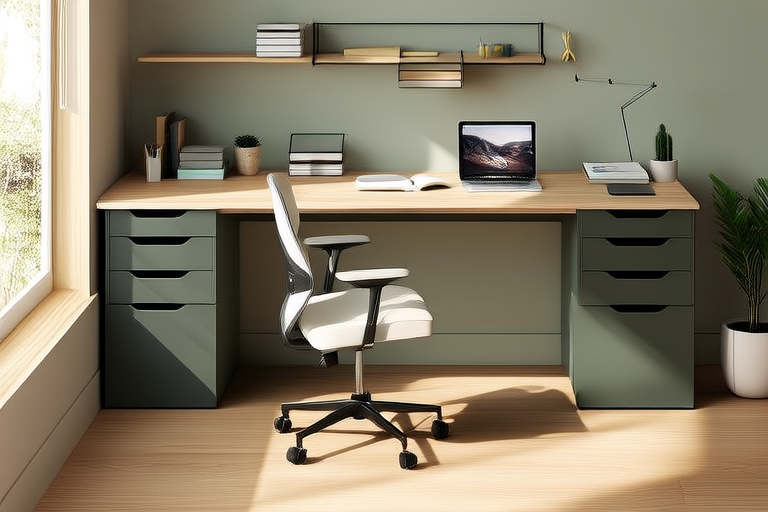10 Tips for Maximizing Space in Your Home Office & Desk Organization
Introduction: The Importance of a Well-Organized Home Office
In today’s fast-paced world, having a well-organized home office is more important than ever. Whether you’re working from home full-time or just need a dedicated space for occasional tasks, a clutter-free and efficient setup can significantly boost your productivity. Not only does a tidy workspace reduce stress, but it also helps you focus better and find what you need quickly. This article will provide you with ten practical tips to maximize the space in your home office and keep your desk organized.
1. Choose the Right Furniture: Size Matters
One of the first steps in creating an efficient home office is selecting furniture that fits well within the available space. Desks come in various shapes and sizes, so choose one that suits both the dimensions of your room and your work style. For example, if you have limited floor space, consider a corner desk or a wall-mounted desk to save valuable ground area. Adjustable standing desks are also great options as they offer flexibility and promote better posture.
Practical Tip:
Measure your room carefully before purchasing any furniture. Ensure there’s enough clearance around the desk for movement and access to electrical outlets.
2. Utilize Vertical Space Efficiently
Maximizing vertical space is key when dealing with limited floor area. Wall shelves, bookcases, and hanging organizers can help store items off the desk surface, keeping it clean and functional. Consider installing floating shelves above your desk to house books, binders, or decorative objects. Alternatively, use under-desk storage solutions like baskets or drawers to hide supplies and paperwork out of sight.
Case Study:
A homeowner with a small apartment used vertical storage solutions to transform their tiny bedroom into a cozy yet productive home office. By mounting shelves along one wall and using a tall filing cabinet, they were able to keep all necessary documents and equipment neatly organized without overcrowding the space.
3. Declutter Regularly: Less Is More
Clutter not only makes your office look messy but also hampers efficiency. Establishing a regular decluttering routine ensures that only essential items remain on your desk. Start by sorting through papers, removing duplicates, and discarding anything no longer needed. Use digital tools to archive important documents instead of keeping physical copies unless absolutely necessary.
Action Steps:
- Set aside time each week to review and organize your workspace.
- Implement a “one-in, one-out” rule for new items brought into the office.
4. Optimize Cable Management
Cables can easily become tangled and create visual distractions. Proper cable management keeps your desk neat and prevents potential hazards. Invest in cable organizers such as clips, ties, and trays to manage wires from computers, printers, and other devices. Labeling cables can further simplify troubleshooting and maintenance.
Recommended Tools:
- Cord wraps
- Velcro straps
- Cable boxes
5. Personalize Your Workspace for Comfort and Productivity
Creating a comfortable environment enhances focus and motivation. Ergonomic chairs, proper lighting, and personal touches like plants or artwork contribute to a pleasant atmosphere. However, these additions should be made thoughtfully to avoid adding unnecessary bulkiness. Select pieces that serve multiple purposes, like a desk lamp that doubles as decor.
Example:
A freelance writer incorporated soft lighting fixtures and potted herbs into their minimalist office design. These elements provided aesthetic appeal while promoting mental well-being.
6. Prioritize Digital Storage Over Physical Files
With cloud technology becoming increasingly accessible, storing files digitally has never been easier. Transitioning from paper-based systems to digital ones reduces physical clutter and allows for easier sharing and backup. Cloud services like Google Drive, Dropbox, or Microsoft OneDrive offer ample storage capacity at affordable rates.
Step-by-Step Guide:
- Scan important documents using a scanner or smartphone app.
- Upload scanned files to your preferred cloud service.
- Create folders for easy categorization and retrieval.
7. Organize Desktop Accessories Systematically
Small accessories like pens, sticky notes, and highlighters can add up quickly and cause chaos if left unattended. Designate specific spots for frequently used items using organizers such as trays, cups, or bins. This practice maintains order and facilitates quick access when needed.
Suggested Organizers:
- Pen holders
- Drawer dividers
- Muli-compartment trays
8. Implement Smart Storage Solutions
Investing in smart storage solutions can make a significant difference in maintaining organization over time. Products like modular drawer units, rolling carts, and stackable containers offer versatile storage options tailored to individual needs. These items often come equipped with features designed to streamline daily routines, making them ideal additions to any home office setup.
Innovative Options:
- Wireless charging stations
- Charging docks
- Stackable document trays
9. Maintain Cleanliness Through Daily Habits
Developing good habits goes beyond initial organization efforts. Incorporating simple practices into your daily routine helps sustain a tidy workspace throughout the year. Some examples include wiping down surfaces regularly, cleaning up after each task, and setting reminders to perform periodic deep cleans.
Habit Formation:
- Keep a microfiber cloth handy for quick spot cleaning.
- Schedule weekly cleaning sessions to address deeper messes.
10. Seek Professional Help When Needed
Sometimes, despite best efforts, achieving optimal organization proves challenging. In such cases, consulting professionals specializing in interior design or professional organizing might be beneficial. They bring fresh perspectives and specialized knowledge that could unlock creative solutions previously overlooked.
Expert Advice:
- Schedule consultations with certified organizers via platforms like NAPO (National Association of Productivity and Organizing Professionals).
- Attend workshops or webinars focused on home office optimization techniques.
Conclusion: Take Action Today!
By following these ten tips, you can transform even the most cramped home office into a functional and inviting workspace. Remember, maintaining organization requires ongoing effort and commitment. Start implementing these strategies gradually, focusing on one area at a time until everything falls into place. With dedication, you’ll soon enjoy a cleaner, more productive environment conducive to success.
